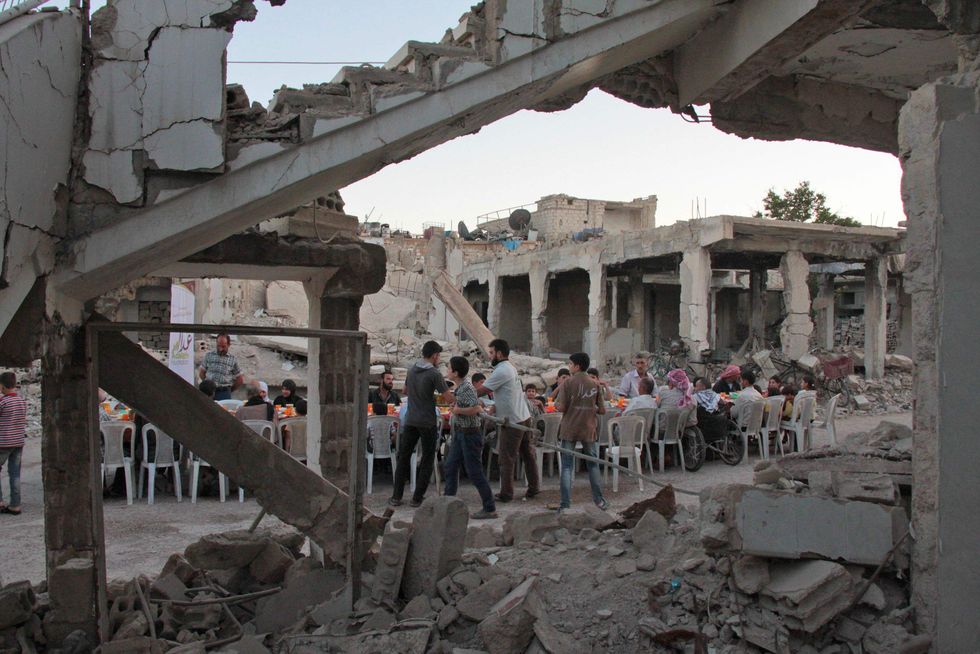
Syrian residents of the rebel-held town of Douma, on the outskirts of the capital Damascus, break their fast with the "iftar" meal Sunday on a heavily damaged street during the Muslim holy month of Ramadan. (Hamza Al-Ajweh/AFP/Getty Images)

Due to the normal ebb and flow of the news cycle, Americans regularly forget the extent to which the United States has been walking on a tightrope in Syria for the last few years.
America's military involvement in the most complicated powder keg in the Middle East has always carried with it the risk of involving the American military in a direct shooting war with the Russians for the first time ever, to say nothing of the potential for destabilizing the delicate balance of power in a region of the world that still exports a significant amount of violent Islamic terrorism worldwide.
The threat of a direct confrontation with Russian forces grew far more serious over the last 48 hours, after U.S. forces shot down a Syrian jet that allegedly dropped bombs on U.S.-allied Syrian Democratic Forces. Russia responded with a drastic escalation in rhetoric, threatening to shoot down any U.S. fighter jet spotted west of the Euphrates River and withdrawing from the 2015 "deconfliction" agreement that was designed to prevent U.S. and Russian forces from finding themselves engaged in direct combat with one another.
It's never safe to assume that Russia means exactly what they say. It is entirely possible that their response this morning is merely a face-saving gesture designed to placate an angry Syrian President Bashar al-Assad, after all. If, however, Russia really means it, then we will soon face a situation that the whole world has dreaded — but somehow avoided — since the end of World War II: U.S. and Russian armed forces exchanging live munitions fire at one another.
Once that genie escapes the bottle for the first time, who knows what it will take to get the genie back in. For that matter, who knows whether the military behemoths will be able to contain hostilities to the Syrian theater, or whether they will spill into other areas of the globe where the United States and Russia have abutting — or even overlapping — spheres of strategic influence.
As if the potential for a drastically escalated conflict with Russia were not serious enough, the Trump administration is contemplating an escalation of military activity in southern Syria that threatens to draw Iran further into conflict with U.S. forces as well. Iranian military elements have long acted in a support role to prop up the Assad regime, and in recent weeks, U.S. forces have conducted defensive operations against these Iranian forces who are operating within the Syrian theater.
A rift has developed within Trump’s foreign policy team concerning the proper response to Iran’s intervention in Syria. According to Foreign Policy:
Ezra Cohen-Watnick, the senior director for intelligence on the National Security Council, and Derek Harvey, the NSC’s top Middle East advisor, want the United States to start going on the offensive in southern Syria, where, in recent weeks, the U.S. military has taken a handful of defensive actions against Iranian-backed forces fighting in support of Syrian President Bashar al-Assad.
These plans have been stridently opposed by the Pentagon, including Secretary of Defense James Mattis, who is said to have personally vetoed two prior proposals to engage the Iranian-backed pro-Assad forces. Mattis, along with Chairman of the Joint Chiefs of Staff Gen. Joseph Dunford, favor keeping the focus on ousting the Islamic State from Syrian strongholds like Raqqa.
Foreign Policy reports that Mattis and Dunford fear that an offensive operation against the Iranian-backed forces will lead to “retaliation against U.S. troops deployed in Iraq and Syria, where Tehran has armed thousands of Shiite militia fighters and deployed hundreds of Revolutionary Guard officers.”
Given that Mattis has for decades been one of the most public Iran hawks on the face of the planet, the fact that he has, on multiple occasions, put the brakes on an anti-Iranian military action underlines the potential volatility of the situation in Syria for United States forces.
And, of course, all this turmoil threatens to boil over at a time when the United States is essentially on a wartime footing with North Korea, where an astonishing three aircraft carriers have been deployed as a show of force against an increasingly belligerent — and now nuclear — North Korean threat. If Syria erupts into an all-out shooting war between the United States and Russia, Kim Jong Un might well view the chaos as an opportunity to establish permanent dominance over the Korean peninsula.
The situation in Syria has been tense for years, but the downing of the Syrian jet may yet act as the catalyst for a chain of events that we cannot yet understand or predict. However, the most likely immediate effect of those events will be a significant amount of death and destruction in one of the world’s most volatile regions.